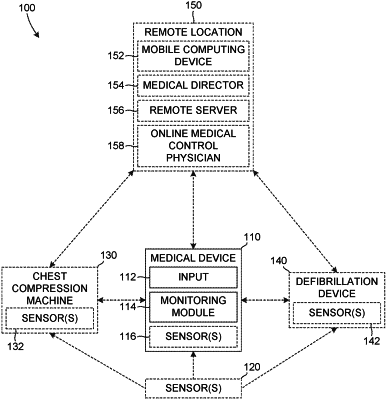| CPC A61B 5/486 (2013.01) [A61B 5/0836 (2013.01); A61B 5/14551 (2013.01); A61B 5/4836 (2013.01); A61H 31/004 (2013.01); A61H 31/005 (2013.01); A61B 5/0002 (2013.01); A61B 5/0205 (2013.01); A61B 5/085 (2013.01); A61B 5/349 (2021.01); A61B 5/7275 (2013.01); A61B 5/742 (2013.01); A61H 2201/501 (2013.01); A61H 2230/045 (2013.01); A61H 2230/065 (2013.01); A61N 1/36521 (2013.01); A61N 1/37 (2013.01); A61N 1/3904 (2017.08)] | 20 Claims |

|
1. A medical device comprising:
an airway sensor configured to detect a level of carbon dioxide expelled from an airway of an individual;
an oximetry sensor configured to detect a blood oxygenation level of the individual; and
a processor configured to:
determine a threshold based on the level of carbon dioxide expelled from the airway of the individual;
determine that the blood oxygenation level of the individual exceeds the threshold; and
determine that the patient has experienced return of spontaneous circulation (ROSC) based on determining that the blood oxygenation level of the individual exceeds the threshold.
|
|
4. A medical device comprising:
a first sensor configured to detect a first physiological parameter indicating a hemodynamic adequacy of an individual, the first physiological parameter being correlated with a confounder;
a second sensor configured to detect a second physiological parameter indicating the hemodynamic adequacy of the individual, the second physiological parameter being non-correlated with the confounder; and
a processor configured to:
determine, based on the first physiological parameter, a threshold;
compare the second physiological parameter to the threshold; and
based on the comparison of the second physiological parameter to the threshold, determine a condition of the individual, wherein the condition comprises a return of spontaneous circulation (ROSC) of the individual, an effectiveness of cardiopulmonary resuscitation (CPR) performed on the individual, or a risk of cardiac re-arrest of the individual.
|
|
12. A device comprising:
a processor; and
memory storing instructions that, when executed by the processor, cause the processor to perform operations comprising:
determining a threshold based on a first physiological parameter indicative of a hemodynamic adequacy of an individual, the first physiological parameter being correlated with a confounder;
comparing the threshold to a second physiological parameter indicative of the hemodynamic adequacy of the individual, the second physiological parameter being non-correlated with the confounder; and
based on the comparison of the second physiological comparison to the threshold, determine whether the individual is experiencing return of spontaneous circulation (ROSC).
|